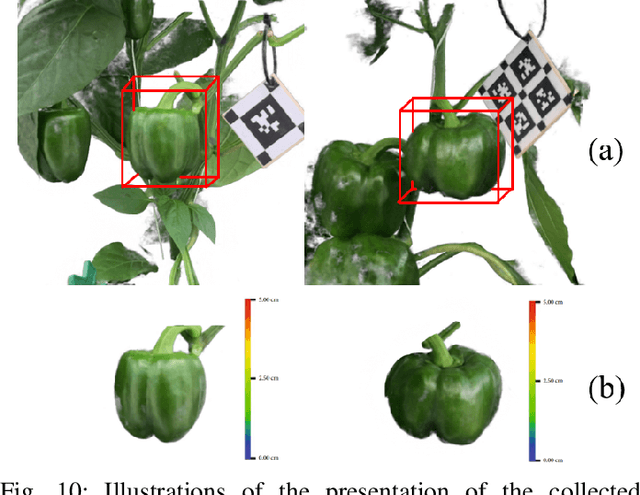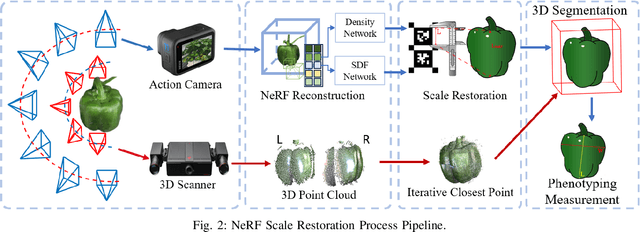Yaoqiang Pan
Accurate Cutting-point Estimation for Robotic Lychee Harvesting through Geometry-aware Learning
Mar 30, 2024Abstract:Accurately identifying lychee-picking points in unstructured orchard environments and obtaining their coordinate locations is critical to the success of lychee-picking robots. However, traditional two-dimensional (2D) image-based object detection methods often struggle due to the complex geometric structures of branches, leaves and fruits, leading to incorrect determination of lychee picking points. In this study, we propose a Fcaf3d-lychee network model specifically designed for the accurate localisation of lychee picking points. Point cloud data of lychee picking points in natural environments are acquired using Microsoft's Azure Kinect DK time-of-flight (TOF) camera through multi-view stitching. We augment the Fully Convolutional Anchor-Free 3D Object Detection (Fcaf3d) model with a squeeze-and-excitation(SE) module, which exploits human visual attention mechanisms for improved feature extraction of lychee picking points. The trained network model is evaluated on a test set of lychee-picking locations and achieves an impressive F1 score of 88.57%, significantly outperforming existing models. Subsequent three-dimensional (3D) position detection of picking points in real lychee orchard environments yields high accuracy, even under varying degrees of occlusion. Localisation errors of lychee picking points are within 1.5 cm in all directions, demonstrating the robustness and generality of the model.
Exploring Accurate 3D Phenotyping in Greenhouse through Neural Radiance Fields
Mar 28, 2024



Abstract:Accurate collection of plant phenotyping is critical to optimising sustainable farming practices in precision agriculture. Traditional phenotyping in controlled laboratory environments, while valuable, falls short in understanding plant growth under real-world conditions. Emerging sensor and digital technologies offer a promising approach for direct phenotyping of plants in farm environments. This study investigates a learning-based phenotyping method using the Neural Radiance Field to achieve accurate in-situ phenotyping of pepper plants in greenhouse environments. To quantitatively evaluate the performance of this method, traditional point cloud registration on 3D scanning data is implemented for comparison. Experimental result shows that NeRF(Neural Radiance Fields) achieves competitive accuracy compared to the 3D scanning methods. The mean distance error between the scanner-based method and the NeRF-based method is 0.865mm. This study shows that the learning-based NeRF method achieves similar accuracy to 3D scanning-based methods but with improved scalability and robustness.
Pheno-Robot: An Auto-Digital Modelling System for In-Situ Phenotyping in the Field
Feb 15, 2024Abstract:Accurate reconstruction of plant models for phenotyping analysis is critical for optimising sustainable agricultural practices in precision agriculture. Traditional laboratory-based phenotyping, while valuable, falls short of understanding how plants grow under uncontrolled conditions. Robotic technologies offer a promising avenue for large-scale, direct phenotyping in real-world environments. This study explores the deployment of emerging robotics and digital technology in plant phenotyping to improve performance and efficiency. Three critical functional modules: environmental understanding, robotic motion planning, and in-situ phenotyping, are introduced to automate the entire process. Experimental results demonstrate the effectiveness of the system in agricultural environments. The pheno-robot system autonomously collects high-quality data by navigating around plants. In addition, the in-situ modelling model reconstructs high-quality plant models from the data collected by the robot. The developed robotic system shows high efficiency and robustness, demonstrating its potential to advance plant science in real-world agricultural environments.
High-fidelity 3D Reconstruction of Plants using Neural Radiance Field
Nov 07, 2023Abstract:Accurate reconstruction of plant phenotypes plays a key role in optimising sustainable farming practices in the field of Precision Agriculture (PA). Currently, optical sensor-based approaches dominate the field, but the need for high-fidelity 3D reconstruction of crops and plants in unstructured agricultural environments remains challenging. Recently, a promising development has emerged in the form of Neural Radiance Field (NeRF), a novel method that utilises neural density fields. This technique has shown impressive performance in various novel vision synthesis tasks, but has remained relatively unexplored in the agricultural context. In our study, we focus on two fundamental tasks within plant phenotyping: (1) the synthesis of 2D novel-view images and (2) the 3D reconstruction of crop and plant models. We explore the world of neural radiance fields, in particular two SOTA methods: Instant-NGP, which excels in generating high-quality images with impressive training and inference speed, and Instant-NSR, which improves the reconstructed geometry by incorporating the Signed Distance Function (SDF) during training. In particular, we present a novel plant phenotype dataset comprising real plant images from production environments. This dataset is a first-of-its-kind initiative aimed at comprehensively exploring the advantages and limitations of NeRF in agricultural contexts. Our experimental results show that NeRF demonstrates commendable performance in the synthesis of novel-view images and is able to achieve reconstruction results that are competitive with Reality Capture, a leading commercial software for 3D Multi-View Stereo (MVS)-based reconstruction. However, our study also highlights certain drawbacks of NeRF, including relatively slow training speeds, performance limitations in cases of insufficient sampling, and challenges in obtaining geometry quality in complex setups.
A Novel Perception and Semantic Mapping Method for Robot Autonomy in Orchards
Sep 01, 2023Abstract:In this work, we propose a novel framework for achieving robotic autonomy in orchards. It consists of two key steps: perception and semantic mapping. In the perception step, we introduce a 3D detection method that accurately identifies objects directly on point cloud maps. In the semantic mapping step, we develop a mapping module that constructs a visibility graph map by incorporating object-level information and terrain analysis. By combining these two steps, our framework improves the autonomy of agricultural robots in orchard environments. The accurate detection of objects and the construction of a semantic map enable the robot to navigate autonomously, perform tasks such as fruit harvesting, and acquire actionable information for efficient agricultural production.
 Add to Chrome
Add to Chrome Add to Firefox
Add to Firefox Add to Edge
Add to Edge